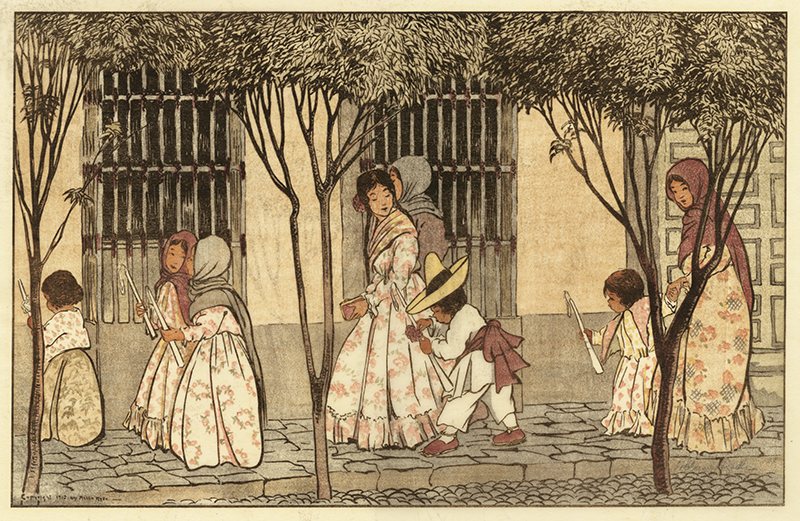Sunday Morning, San Angel, Mexico is a color woodcut from 1912 by American artist Helen Hyde. It is pencil signed within the image in the lower right and pencil titled at the lower left corner of the paper. The reference is Mason 104. The total number of impressions is unknown but this impression is clearly numbered 199 following the signature. Sunday Morning, San Angel, Mexico was printed by the artist on fine, ivory wove Japanese paper and was illustrated in the article “The Colour Lure of Mexico” in the November 1913 issue of The International Studio. This large color woodcut measures 10-5/8 x 16-5/8 inches.
San Ángel was once a rural village outside of Mexico City and today it is a colonia or neighborhood of Mexico City. It is a charming neighborhood of cobblestone streets and colonial homes. In her color woodcut from 1912, Hyde captured a family beautifully attired in their Sunday best promenading along a stone walkway on their way to mass. The children hold long tapers which suggest that the day is Dia de la Candelaria, Candle Mass Day in Mexico.
Helen Hyde, printmaker and illustrator, was born in Lima, New York on 6 April 1868, but spent a cultured childhood in Oakland, California. At the age of twelve, Hyde began art instruction under Ferdinand Richardt but it ended abruptly two years later when her father died and her family relocated inß San Francisco. Helen and her mother moved to Philadelphia and, after her graduation from Wellesley School, she returned to San Francisco and studied at the School of Design. Hyde studied briefly with Kenyon Cox at the Art Students League in New York between 1888 and 1889. The following year she departed on a four-year sojourn in Europe, which included studying with Franz Skarbina in Berlin, Raphael Collin and Albert Sterner in Paris, and months in Holland and England.
In Paris, Hyde met Félix Régamey who introduced her to the “loveliness of things Japanese” and this meeting was to have a profound effect on her life and work. Returning to San Francisco, Hyde sought out subjects in Chinatown and produced her first series of color etchings. In 1899, she voyaged to Japan where she became an ardent student of the Japanese language and a student of classical brush painting with an Austrian artist working in Tokyo, and it was from him that she learned the skills of carving wood blocks. Hyde eventually accepted the Japanese system of divided labor and employed Japanese carvers and printers (Shohiro Murate carved her woodcuts for eleven years). Japan was Hyde's home until 1914 when she returned to the United States.
Hyde exhibited both nationally and internationally and her work won honors in Japan. She was awarded the gold medal at the Alaska-Yukon-Pacific Exhibition in Seattle in 1909 and the bronze medal for woodcut at the Panama-Pacific International Exposition in 1915. Hyde was a member of the Chicago Society of Etchers, the Printmakers Society of California, the Chicago Society of Artists and a life member of the Société de la Grauvre en Couleur.
The work of Helen Hyde is represented in the collections of the Brooklyn Museum, New York; the Glenbow Museum, Calgary, Alberta; the Art Institute of Chicago, and the Smith Museum of Art, the University of Chicago, Illinois; the University of Oregon Museum of Art, Eugene; the Indianapolis Museum of Art, Indiana; the Zimmerli Art Museum, Rutgers University, New Brunswick, New Jersey; the Metropolitan Museum of Art, and the New York Public Library, New York; the Pennsylvania Academy of the Fine Arts, Philadelphia; the Fine Arts Museums of San Francisco, California; and the Library of Congress, and the Smithsonian American Art Museum, Washington, D.C.
Helen Hyde died on 13 May 1919 in Pasadena, California.



